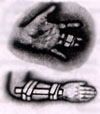Treatments
And Procedure

Here
we provide a guide to the principles of treatments, and
simple how-tos for the most basic procedures- such as applying compresses,
bandaging and splinting. Familiarizing Yourself with these charts
and tables now will pay off when you need to use them
later.
Compresses
Heating
hot water bottles, gauze, washcloths, towels, Popsicle, and ice
cubes in plastic bags all can serve as compresses,. Refer
to the treatment principles or to specific entries in the treatment
section to determine what kind of compress is best for a given
injury or ailment.
-
Wet
a towel or washcloth with hot or cold water, wring and fold
or wrap an ice cube in a washcloth. Apply to face, back,
joints, limbs as necessary ( put in plastic bag if moisture
isn't necessary).
-
Apply
a plastic bag filled with ice to
mouth injuries.
-
Press
a wad of gauze or other clean cloth to a bleeding wound and
hold firmly in place to reduce flow of blood.
Bandages
Adhesive
bandages, gauze pads, tape, and elastic bandages help protect
wounds from injury and promote healing.
-
Basic
bandage : Stop bleeding and clean wound before applying a gauze
pad or adhesive bandage ( tape if needed).
-
Elastic
bandage : Stop bleeding and apply dressings if
needed, then wrap with even, gentle pressure. Unwrap
several times a day if your doctor recommends it.
|

|

|

|
|
1. Cut as shown |
2. Twist 3600 |
3. Push edges of wound &
together & apply |
-
Butterfly
closure ( for closing long or deep cuts ): cut 1/2 inch
adhesive tape as shown; twist one end 3600 until
both ends
have adhesive sides down. Push edges of wound together and
apply; then cover with gauze or an adhesive bandage.
-
Removing
bandages : Leave bandages in place 24 hours unless you're
directed otherwise. Then remove and change bandages as
necessary. Soak gauze in cold water before
removing it: remove in direction of wound ( rather
than across it) to avoid disturbing the scab.
Splints
Tape,
string, cloth, gauze, newspaper, rulers, and boards can help to immobilize
injured fingers or extremities while you seek help or
allow the injury to heal.
Note
: don't reposition limbs that may be fractured, and
don't move children with suspected neck injuries.
 |
-
Tape
injured fingers or toes to adjacent ones.
-
Tape
or tie a ruler, board , or newspaper around a broken
arm or leg. Support arm with a sling or length of
gauze.
-
Tie
towels firmly around sprained ankles wrists.
|
Slings
Slings
can be fashioned from any available piece of cloth that is large
enough. They serve to elevate and help immobilize the arm.
Keep
Notes
Keep
name, address and telephone numbers of your near health center for child and
mother care.
